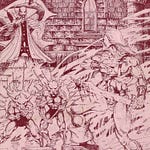White Dwarf Issue #5, published Feb/Mar 1978, stands as a fascinating snapshot of the early British roleplaying and wargaming scene, a time when the hobby was still finding its feet and the boundaries between wargaming, fantasy, and science fiction gaming were fluid and often hotly debated. In his editorial, Ian Livingstone addresses issues arising from copyright, reflecting a hobby amid transformation, and setting the stage for a magazine that is a passionate advocate for the legitimacy of fantasy gaming.
The issue’s content is eclectic but revealing of the period’s preoccupations. The lead article is a detailed review of Chivalry & Sorcery (C&S) by Lew Pulsipher, which is not only a rules review but a philosophical treatise on the contrasting aims of playability and simulation in fantasy roleplaying. Pulsipher’s analysis is nuanced; he recognises the ambition and rigour of C&S, lauding its attempt to create a medieval milieu with authentic feudal and magical systems, but he is also critical of its complexity and rigidity, arguing that its simulationist ethos can become a straitjacket for imaginative play. This review is a microcosm of the broader debates of the late 1970s, as the hobby wrestled with the tension between realism and fun, and it is written with a clarity and depth that remains instructive.
Another standout is John Norris’s review of the Der Kriegspielers Fantastique’s miniature line. Norris’s writing is both evocative and practical, offering a consumer guide and a meditation on the importance of miniatures in bringing fantasy worlds to life. He is particularly attentive to the suitability of these figures for Tolkien-inspired gaming, providing a granular breakdown of the range’s strengths and weaknesses. He also praises the animation and variety of the figures, while lamenting their high price and the poor quality of the larger models. This kind of detail-oriented, hands-on review is a hallmark of early White Dwarf, and it underscores the magazine’s role as a bridge between the creative ambitions of players and the realities of the marketplace.
Don Turnbull’s Monsters Mild & Malign continues his project of cataloguing and expanding the bestiary available to D&D referees, drawing on both original creations and monsters from other fanzines and publications. The article is notable for its inventive spirit and willingness to adapt ideas from across the gaming landscape, and it also signals the forthcoming launch of the Fiend Factory column a feature that would become one of White Dwarf’s most influential contributions to the hobby, eventually supplying monsters that would be incorporated into official D&D canon. Turnbull’s approach is playful and systematic, and his use of the Monstermark system for rating monster difficulty is an early attempt at quantifying challenge in a still evolving rules environment.
The D&D Campaigns column by Lewis Pulsipher is another highlight, offering practical advice on campaign structure, character management, and rules adjudication. Pulsipher’s writing is pragmatic and occasionally opinionated, reflecting the experimental nature of early campaign play and the lack of consensus on best practices. His recommendations for character families, multi-world campaigns, and differentiated experience and treasure division based on alignment are thoughtful and prescient, anticipating many later developments in campaign design.
The Open Box review is a window into the rapidly diversifying market of the late 1970s. Reviews of supplements like Book of Monsters, Book of Demons, and Book of Sorcery are balanced and critical, with reviewers weighing utility, originality, and value for money. The review of Fantasy Games Unlimited’s War of the Ring is particularly telling. While the game is praised for its clarity and movement mechanics, it is critiqued for its expense and presentation; again, a reminder of British gamers’ financial and logistical barriers at the time.
Elsewhere, the magazine features a report on Games Day III, which vividly captures the excitement and chaos of early conventions, and a column on Metamorphosis Alpha that offers practical advice for integrating survival mechanics into play. The “Treasure Chest” section provides a grab bag of new house rules and magic items, including Brian Asbury’s innovative experience system, which attempts to reward players based on damage dealt to monsters rather than simply dividing experience equally, a sign of the ongoing experimentation with core mechanics.
Letters to the editor round out the issue, offering both constructive criticism and praise and revealing an engaged, opinionated readership eager to see the magazine reflect the realities of the UK gaming scene. The classified ads and club listings further reinforce White Dwarf’s role as a community nexus.
In retrospect, White Dwarf Issue #5 is both a product of its time and a harbinger of future things. Its editorial voice is earnest and passionate, its articles are occasionally polemical yet substantive, and its reviews are rigorous and unafraid to criticise. The magazine’s willingness to tackle philosophical questions, publish lengthy and detailed rule analyses, and serve as a platform for established and emerging voices marks it as a vital document in gaming history. While later issues would focus more on Games Workshop’s products, these early editions remain invaluable for their breadth, depth, and sense of possibility.











Share this post